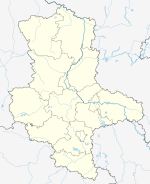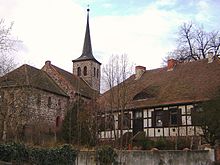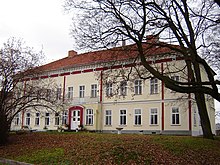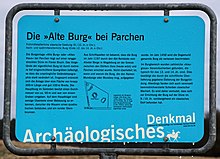Pair
|
Pair
City of Genthin
|
|
|---|---|
| Coordinates: 52 ° 21 '10 " N , 12 ° 4' 53" E | |
| Height : | 37 m above sea level NHN |
| Area : | 41.23 km² |
| Residents : | 957 (1993) |
| Population density : | 23 inhabitants / km² |
| Incorporation : | April 30, 2002 |
| Postal code : | 39307 |
| Area code : | 039345 |
Location in Saxony-Anhalt
|
Parchen is a district of the city of Genthin in the district of Jerichower Land in Saxony-Anhalt . Parchen is located 7.6 kilometers southwest of the city center on Bundesstraße 1 .
geography
In the village, the district road 1206 branches off to the neighboring village of Bergzow to the north . The wetland of the Fiener Bruch begins in the east, while the Kiehnheide and Kappenberge forest areas extend to the north and south. Meadows spread out in the west of the village. The northeastern settlements Wiechenberg and Hüttermühle belong to the Parchen district, which is on average 38 meters above sea level .
history
The area of today's Parchen belonged to the Slavic settlement area from the 7th century. The place is mentioned for the first time in a document of the Archbishop of Magdeburg Adelgot from the year 1108, in which the village then called "Boroschei" is listed as the property of the Magdeburg Berge monastery . Initially as a wooden structure, the first church was built in 1147 on a hill protected by a defensive wall, which was replaced by a field stone structure in 1154. Reinbod, abbot of the Berge monastery, built a castle 2.4 kilometers east of the village in 1197, which was mentioned in a document from Pope Innocent III. from 1209 is listed as "castrum Mundzoige". It was protected by a wall and several moats. Due to disputed fundamental rights, the castle had to be moved to the southern edge of the town in 1220. The new castle was mentioned several times from 1276 as "castrum archiepiscopi" and in connection with it in 1276 the knight Rembert was named as bailiff. In 1389, the Archbishop of Magdeburg, Albrecht II. Parchen, granted the right to hold two annual fairs, which took place on Midsummer Day on June 24th and Simon Judea on October 28th. In the Middle Ages, the villages of Dürremark, Golitz, Kladrun, Schönfurt and Rohrbeck still belonged to Parchen, but they were destroyed during the fighting between Archbishop Günther and the Anhalt princes in 1405–1407 and were not rebuilt. The castle, which was occupied by Count Siegesmund von Anhalt in 1405, was also involved in the conflict. At that time, lord of the castle was Werner von Kracht, who had owned the castle since 1380. Jahn von Kotze bought the castle in 1407, followed by Cuno von Eichstedt in 1458. When Kurt von Byern bought the castle in 1472, it was in desolation. During the Thirty Years War , Croatian soldiers attacked the village in 1631, murdered a farmer and set fire to houses. The residents fled the intruders and did not return to their village until 1645.
In 1710 a mill was built in Parchen, which was powered by the water of the Parchengraben. The drainage of the Fiener, which began in 1744 at the instigation of the Prussian King Friedrich II , provided for further upswing in the village , as a result of which colonists were settled to cultivate the newly won land. The settlement of colonists resulted in the village of Wiechenberg in 1765, initially under the name of Birkheide. In 1768, Rudolph Johannes Heinrich von Byern merged the two Byers' estates, which had been managed separately since the 16th century, and in 1780 had a simple mansion with a baroque park built in place of the dilapidated castle over a period of three years. After a large fire that destroyed almost the entire town in 1827, the manor house was rebuilt from 1830 to 1832 by the Berlin architect Friedrich August Stüler in a classicist style and the park was converted into a landscape park based on plans by Peter Joseph Lenné .
On the occasion of the Prussian administrative reform Parchen was in the 1818 district Jerichow II in Magdeburg Region incorporated. In 1821 the Chaussee Magdeburg – Berlin and in 1846 the Magdeburg – Potsdam railway line was completed. Both traffic routes touched Parchen without significantly changing the character of the village. The industrialization that started elsewhere was only noticeable through the settlement of further mills and a starch factory. A post mill built in 1840 still exists today as a monument and landmark of Parchen. The starch factory soon had to close again.
In 1890, Parchen's oldest club, the Workers' Gymnastics Club, was founded. It was followed in 1899 by the "Germania" cycling club and in 1913 by the "Hohenzollern" cycling club. On April 1, 1927, the volunteer fire brigade was launched. With the exception of the volunteer fire brigade, all other clubs were liquidated after the Second World War . The manor was taken over by the von Schnehen family in 1922. On September 30, 1928, the Parchen manor was merged with the Parchen rural community. In 1945 the property was expropriated and in 1953 the remaining farms were transferred to the LPG "Bundschuh". In 1981 a new school building was put into service, and in 1988 a new kindergarten was built. The kindergarten was built on the grounds of the manor park, two thirds of which had already been destroyed by other functional buildings.
After the end of the GDR rule, agriculture was privatized by four resettlers and an agricultural cooperative. In addition, small craft businesses and other trades established themselves. On May 15, 1994, the Parchen Nature and Local History Association was founded, and on October 4, 1997, the residents were able to open a new village community center with the “Klappermühle”. In 1991 the Parchen high school was closed. After renovation work, the “Albrecht Dürer” school for the disabled has been housed in the school building since 2002.
politics
On May 1, 2002, the Parchen municipality was incorporated into the city of Genthin.
coat of arms
Blazon : “Quartered; Fields 1 and 4: in blue a silver windmill with a black roof and stand, fields 2 and 3: in silver a black hound sitting left looking back. "
The coat of arms was designed by the local heraldist Jörg Mantzsch and approved by the state government on December 1, 1993. It shows a bracket from the Byern coat of arms and a post mill that still exists today.
Historical seal image
The former Parchen community already had a coat of arms-like seal image in its community seal. This was used in the period after the Second World War until around the introduction of the districts and counties in the GDR (1945–1952). Another source is the County Home Museum in Genthin.
Buildings
- The village church of Parchen is located in the center of the village, on Kirchstrasse, which branches off to the southeast from the main road. It stands on a hill surrounded by a natural brick wall and was built in its current form after a fire in 1827 using Romanesque remains.
- The former manor house, now known as Schloss Parchen , to the northeast of the church, was built in 1780 for the manor owner Rudolf Johannes Heinrich von Byern instead of a ruined medieval castle . In 1830 the renovation took place in the classical form that is still in existence today .
- The Parchener post mill stands on the Mühlenberg at the southwest entrance to the village. It was originally in the Altmark and was bought in Parchen in 1840. The wooden mill body has a rectangular floor plan of six by eight meters and rests on a four-braced trestle that is built on stone foundations. At its center is the so-called 60 cm diameter house tree made from Canadian oak . It ensures that the mill box can be rotated. The four-part wing cross has a span of 18 meters. The mill was owned by the Knak family without interruption from 1840 to 1971. In 1974, the local authority acquired the mill, which is now a listed building and is used as a technical museum.
- Castle ruin 'Alte Burg' with ramparts. First early medieval Slavic settlement, then medieval castle. Abandoned since at least 1458, later only a ruin.
Sons and daughters
- Rudolf von Byern (1844–1913), manor owner and member of the Prussian manor house
literature
- Handbook of Historic Places. Volume 11: Province of Saxony Anhalt. Alfred Kröner Verlag, 1993, ISBN 3-520-31402-9 .
- Georg Dehio: Handbook of the German art monuments. Volume I: Saxony-Anhalt. Deutscher Kunstverlag, 2002, ISBN 3-422-03069-7 .
- CD Saxony-Anhalt - Official topographic maps. State Office for Land Surveying and Geoinformation, 2003.
Web links
- Parchen district on Stadt-Genthin.de
- Parchen ( memento from May 19, 2013 in the Internet Archive ) on jerichower-land-online.de
- Förderverein Schloss Parchen eV
Individual evidence
- ↑ Administrative region of Magdeburg (Ed.): Official Gazette of the Government of Magdeburg . 1928, ZDB -ID 3766-7 , p. 224 .
- ↑ Jörg Mantzsch : The coat of arms of the Parchen community, documentation on the approval process , deposited with the Ministry of the Interior of Saxony-Anhalt 1993 (report: State Main Archive Magdeburg)
- ↑ Old Castle: Many puzzles and even more thorns. Volksstimme, accessed on January 23, 2020 .








